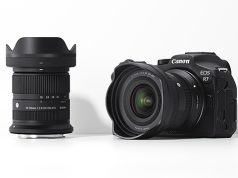As Wikipedia puts it: Stendhal syndrome . . . is a psychosomatic disorder that causes rapid heartbeat, dizziness, fainting, confusion and even hallucinations when an individual is exposed to art, usually when the art is particularly beautiful or a large amount of art is in a single place. The term can also be used to describe a similar reaction to a surfeit of choice in other circumstances, eg, when confronted with immense beauty in the natural world.
That, in a nutshell, is where the imaging industry is today, yes . . . no? In the end, it depends on your perspective and/or focal length. In my 40 years in this confounded business, I’ve never before seen such a plethora of choices, good, bad and indifferent. I feel faint.
Let’s start with the “oldest” technology out there: Lomography. Hats off to these inventive souls, who are flying in the face of conventional wisdom and making films and film cameras available to all. Quite cleverly they have made a success of reintroducing “old” cameras at “new” (ie, high) prices. For example, Hong Kong’s vintage Diana camera, which used to ship decades ago for about a buck FOB, now retails at more like $50. The Lomos have dug up old Yashicas (Electro 35GSN) and Chinons (or Chinon knockoffs), and they have also created a community of like-minded souls with constant newsletters, e-mail offers, etc. Go search for Lomography if you don’t know them; there’s a lot to be learned from the new kings of retro-niche marketing. And niching is where it’s at these days.
Niche Matter
While we’re niching, let’s consider theQ camera, a self-described “modern vintage” camera with lots of original thinking. The outer body has a rubberized coating, and there’s a see-through (no elements) viewfinder. It’s water-resistant (3 feet for 30 minutes) with a save & share button for instant connectivity. The LED ring flash surrounds the lens—clever. Instead of a flash on-off button, it has two shutter buttons: one with flash, one without. The price is a tad “nichey” too, $199, and a recent visit to the site revealed that all nine colors are currently out of stock! It’s a crowdfunding project
The most successful niche right now is occupied, and dominated, by GoPro. I met the founder (and top dog) Nick Woodman about a decade ago. I tried to get Kodak interested in his ideas but they yawned, and I left him to his own devices. Silly me. I’ve read that the GoPro Hero3 is the world’s best-selling single digital camera model (but can’t now trace where I read that, sheesh!). He has created a very focused company, whose products pop-up on TV programs seemingly constantly. The GoPro shape does not lend itself to using a zoom lens, but nobody seems to care. The cameras are so good and so affordable that filmmakers festoon them in multiples when they do a shoot, and if one or two get damaged, who cares? I believe GoPro has revolutionized Hollywood, perhaps even more so than such heavyweights as RED, and Woodman richly deserved the Emmy that he won in 2013. GoPro has several competitors, including iON, ReplayXD and even Sony, excluding Contour who went belly up; they were being eyeballed by at least one potential savior as I write this.
Digital cinema cameras have also changed Hollywood at the blockbuster level, too; in the old (film) days, the biggest film magazines only allowed for about 20 minutes of shooting, after which filming paused while the camera was reloaded under its soundproof cover. No more; digicams can shoot 1080p images onto memory cards for hours. Phew. Not to mention up-and-coming 4K capture with its stunning clarity. (Thankfully today memory is dirt cheap. In 2005 I helped a company called Cornice that was offering a one-inch-diameter 1GB hard disk that fit into a CF slot for only (!) $70 FOB; we offered it to camera makers but they were reluctant to adopt it for some unknown reason!)
Another “nicher” I helped years ago is Dr. Ren Ng of Lytro, the “refocus” kings. He uses a “light field” system that (as far as I can tell) takes multiple exposures simultaneously to create multiple focus fields. In simple terms, if he uses 10 such fields, the effective resolution of the image drops by a similar factor. Am I right? Help!
Looking over his shoulder today is Nokia, who is taking advantage of cheap memory and fast processing chips to take rapid multiple exposures as the shutter button is pressed, one after another, each at a different focus plane, then allowing subsequent viewing at each plane. This simulates the refocus effect but retains the full resolution of the sensor. This could be a threat to Lytro, we’ll see. The future is fuzzy.
Digicam Chatter
So on to digicams in general. Kodak used to be a leader in digicam development, even supplying to Apple. Imagine! Now their digicam brand is licensed to JK Imaging, supported and supplied by Asia Optical (AO) of Taiwan (who also feed General Imaging/GE). Alas, the export figures out of Taiwan for Q3 state that AO had only 4.73% of the five and a bit million units shipped. Ability had just under 50%; Altek just over a quarter, and Foxconn/Hon Hai/Premier just under 19%, said Digitimes research. The biggest buyer was Nikon (over 38%), then Fujifilm, Sony, Casio, Olympus, Panasonic and Samsung.
But wait, there’s more: the Q4 estimates came out October 31, and they were even creepier: Ability will account for 65.06% of the shipments, Altek 25.31%, Foxconn 6.17%, and Asia Optical only 3.46%. So it would seem that Kodak cameras might not have landed under many Christmas trees in 2013. NPD reported that Kodak had only a 0.6% (digital point and shoot) unit market share for the 12 months ending September 2013, versus 10.2% the year before.
This will not bother Charlie Saka, as his Sakar team seems to be all about, what with Vivitar and Polaroid brands amongst others. There’s a spot of bother for Sakar regarding a Polaroid M1836 camera that looks amazingly like a Nikon 1, which somebody in the supply chain should have noticed. When I was buying for (the former) Vivitar, our suppliers were averse to copying anything, bless them. But in my Haking days, Olympus got a bit more than miffed when Haking (before I joined) “adapted” the famous huge-selling Olympus Trip 35 by switching from photocell to CdS metering, but alas also copying an internal mistake that Oly had made, thus rendering their denial legless. Those were the days!
Back in 2004 I took a proposal to photokina on behalf of MicroVision for a mirrorless, interchangeable-lens compact digital camera with an electronic eye-level viewfinder and video capture mode (as well as still mode, of course). No patent coverage; we were just trying to flog their viewfinder. Nobody bit; the EVF was too bulky at that stage. By 2013 the MILC format was the hottest thing in digicams, but it wasn’t catching on as quickly as hoped in the U.S., maybe under the relentless onslaught of smartphones.
IDC calculated that in Q3, some 254.8 million smartphones were shipped worldwide. Many (most?) of them would have featured two cameras. So, we see that the phone guys shipped 50 times, maybe 100 times, as many “cameras” as did the Taiwanese. Yeah, yeah, it’s not apples to apples, but it sure gets one’s attention. Be that as it may, one must admire the quality of the designs coming out of Japan these days. The big guys are spitting out fabulous high-end models, with big sensors, dual viewfinders (LCD and EVF), clever modes, video capture, wonderful lenses, etc., etc. Recovering the development costs will be quite a trick, methinks.
Smartphone Smatter
Back now to smartphones: the new kids on the block, with the biggest muscles. As we just saw, over a quarter of a billion were shipped in Q3, up 39% from last year’s Q3. Keep this up for a few years and everyone on the planet will own one; the NSA will go crazy trying to bug them all, especially since a third of them seem to be going to China.
The top shipper was Samsung with 31.4%, followed by Apple (13.1) and Huawei with a mere 4.8%. Hah! That’s still 12 million or so for poor old Huawei. Only 12 million . . . sheesh. What camera maker would not like to have that number?
Qualcomm just announced a new smartphone-processing chip that supports 55MP sensors; you have been warned! Microsoft has RAW image capture for smartphones. You’ve already seen Sony’s new QX lens-style camera modules that clip onto smartphones; the Sony part captures, the phone part acts as a viewfinder and storage (and sends images to the Internet).
Last year I stumbled across a company called Artefact in the rainy corner of the USA, whose WVIL concept camera witnesses an uncanny premonition of the QX. My attempts to solicit an admission of lack of coincidence from Artefact have fallen on blind eyes, suspiciously, but I have high hopes for the success of the QX. The concept is genius.
3D Flatter
Speaking of genius, let us salute 3D printing—the next logical step from minilabs and a segment that every camera or printer company should be studying, and fast.
HP has said that it’s aiming for entry this year, which makes sense as they are so strong in 2D printing. Stratasys is a leader in the $3 billion industry (in 2013) and they expect it to double by 2016; I think they’re too conservative. 3D Systems is beginning to gobble up ancillary companies to support its popular 3D printer portfolio. Scanners are dropping in price; they feed data to the printers. Printers can be used for production lines (“additive manufacturing”) and are especially useful for prototyping and small production runs. Even NASA is planning to send a printer to the International Space Station to make spare parts in a hurry from programs beamed up from Earth.
While we’re up in space, let’s end with a view of the cloud. Facebook has more than a billion active users a month. Google+ has 540 million or so, up from 390 million the year before. Most digicams are not linking to the cloud, but all smartphones are. One of my (famous) buddies has designed a tiny 3x zoom lens for smartphones; he’s waiting for his patent now. The future is getting clearer every day.
Happy CES!





